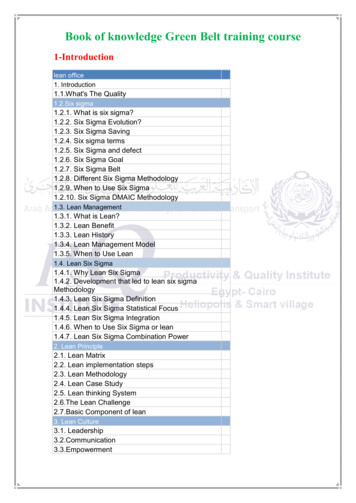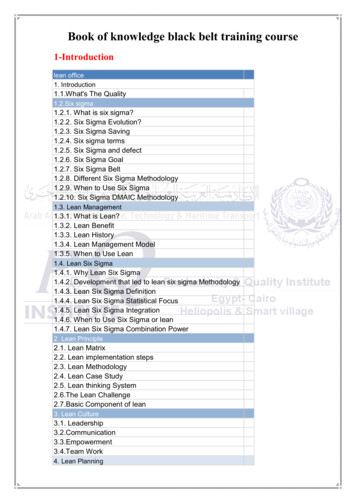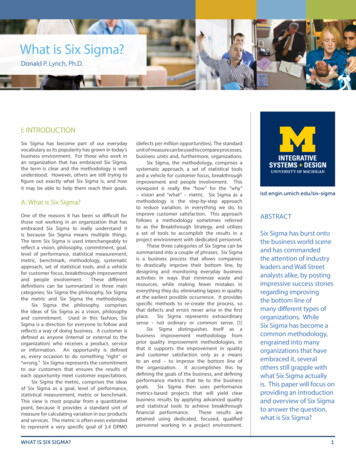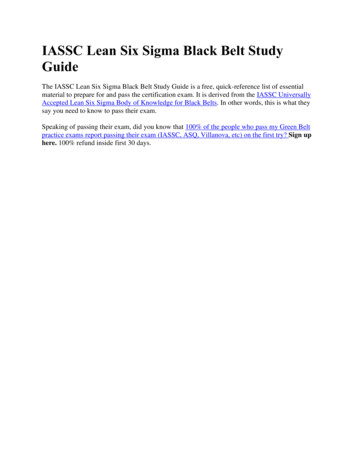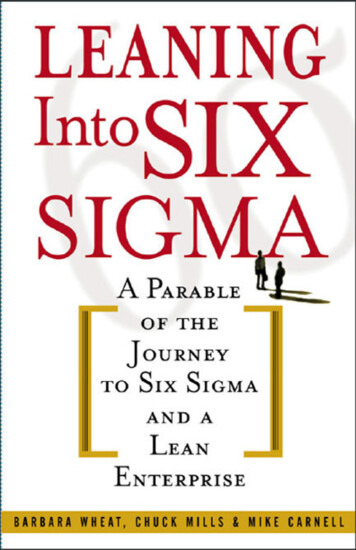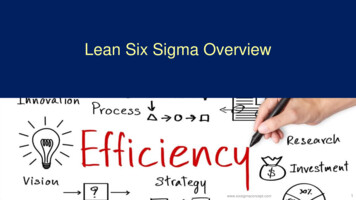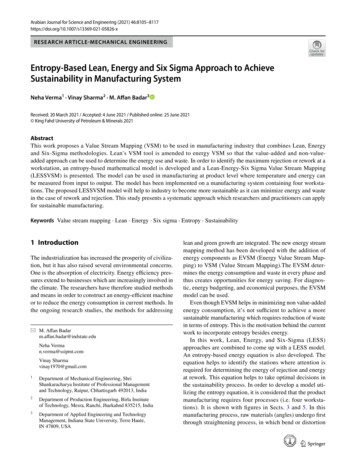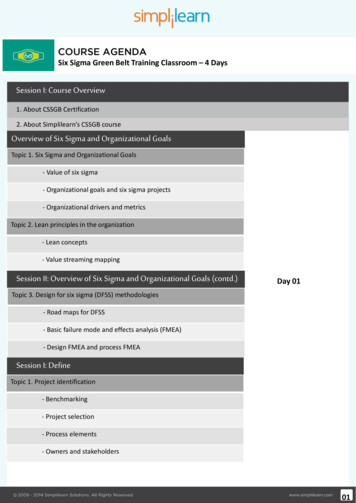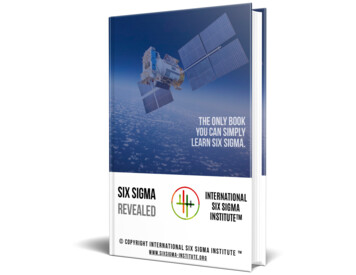
Transcription
Master ThesisSoftware EngineeringThesis no: MSE-2008-21November 2008Applying Six Sigma in SoftwareCompanies for Process ImprovementAdnan Rafiq KhanLong ZhangSchool of EngineeringBlekinge Institute of TechnologyBox 520SE – 372 25 RonnebySweden
This thesis is submitted to the School of Engineering at Blekinge Institute of Technology inpartial fulfillment of the requirements for the degree of Master of Science in SoftwareEngineering. The thesis is equivalent to 2*20 weeks of full time studies.Contact Information:Author(s):Adnan Rafiq KhanAddress: Folkparksvagen 1905, 37240 Ronneby, Sweden.E-mail: adnanrafiqkhan@gmail.comLong ZhangAddress: Villa Flora 951, 37236 Ronneby, Sweden.E-mail: zhl10154@gmail.comUniversity advisor(s):Conny Johansson(Head of Department, Department of Systems and Software Engineering)School of EngineeringBlekinge Institute of TechnologyBox 520SE – 372 25 RonnebySwedenInternetPhoneFax: www.bth.se/tek: 46 457 38 50 00: 46 457 271 25ii
ACKNOWLEDGEMENTFirst of all we thank our supervisor, Conny Johansson, for continuously providing thesupport, encouragement and motivation during the thesis. His advices, suggestionsand feedbacks were really helpful and made this effort an enjoyable one.We are thankful to our faculty reviewer Dr. Robert Feldt. His feedbacks and commentswere very useful to design this thesis. We would like to thanks Mr. Kai Xiao, a studentat BTH, for introducing us to Miss. Cong Lou for help in this thesis. We are very muchthankful to Miss. Cong Lou, a Green Belt in Six Sigma and working in China. She wasvery cooperative during the interview and case study and provided us related materialon the right time.We are thankful to Mr. Jörgen Christmansson for his help in our thesis. He was verycooperative during the interview. He provided us all the necessary information on time.We would like to thank Mr. Haroon Rafiq Khan, a Green Belt in Six Sigma andworking in Mobilink, Pakistan. Throughout this thesis works his tips were very useful.We would like to thank our families for their support throughout our academic studies.Their continuous support made it possible for us to come to Sweden for highereducation.We are thankful to our friends Muzaffar Khan, Aleem Ahmed, Muzaffar Hameed,Jianchuan Ping, Hong Wu and Michael Deng for making our stay in Sweden anenjoyable and memorable experience.1
ABSTRACTModern society has a higher demand for qualitythan it had before. There is a Plethora of qualityimprovement techniques available which makes itharder for companies to decide which one to apply.They need support in this decision and in knowing howto apply the chosen techniques, if they want to improvetheir business and stay competitive.Six Sigma approach is a very successfulmanufacturing quality improvement tool. In the last twodecades, it has helped many companies to success.Recently, the Six Sigma approach was introduced in thesoftware development industry. Some softwarecompanies have been trying to adapt Six Sigma for theirbusiness and development processes. But there aremisconceptions about the applicability of Six Sigma insoftware‟s. Furthermore there is no generic softwarequality improvement solution based on Six Sigma. Sothere is a demand to debunk the misconceptions relatedto the applicability of Six Sigma. And to develop ageneric software company quality improvementsolution based on Six Sigma approach. In this thesis wetake a first step towards such a solution.The thesis starts from Six Sigma conceptidentification and manufacturing investigation. Afterconducting interviews, a case study and several casestudies reviews, we detail our method. We expect thesisresult to be useful for software companies whenapplying Six Sigma in their company for processimprovement.Keywords: Software Quality, Quality ImprovementTool, Six Sigma and Process Improvement2
CONTENTSAPPLYING SIX SIGMA IN SOFTWARE COMPANIES FOR PROCESS IMPROVEMENT .IACKNOWLEDGEMENT . 1ABSTRACT . 2CONTENTS . 31.INTRODUCTION . 61.11.21.31.41.52MOTIVATION . 6AIMS AND OBJECTIVES . 6RESEARCH QUESTIONS . 7RESEARCH METHODOLOGY . 7OUTLINE . 8INTRODUCTION TO QUALITY AND SIX SIGMA . 92.1.1 Definition . 92.1.2 Why Quality Improvement . 102.1.3 Software Quality . 112.1.4 Software Process Improvement. 122.2SIX SIGMA . 122.2.1 History . 122.2.2 Definition . 132.2.3 As a Metric . 132.2.4 As a Methodology . 152.2.5 As a Management System . 162.3SUMMARY. 163TOOLS AND TECHNIQUES IN SIX SIGMA . 183.1INTRODUCTION . 183.2SEVEN QUALITY CONTROL TOOLS. 183.2.1 Check Sheet . 183.2.2 Histogram . 193.2.3 Pareto Chart . 193.2.4 Cause and Effect Diagram . 193.2.5 Stratification . 193.2.6 Scatter plot . 193.2.7 Control chart . 203.3SPECIAL TOOLS . 203.3.1 Brainstorming . 203.3.2 Affinity Diagram . 213.3.3 High-Level Process Map (SIPOC Diagram) . 213.3.4 Measurement System Analysis (MSA) . 213.3.5 Voice of the Customer (VOC) Method . 223.3.6 Kano Analysis . 223.3.7 The Others . 233.4SUMMARY. 234SIX SIGMA IN MANUFACTURING . 254.1MANUFACTURING CORPORATE FRAMEWORK . 254.1.1 Top Management Commitment . 254.1.2 Stakeholder Involvement . 264.1.3 Training Scheme . 264.1.4 Measurement System. 274.2IMPROVEMENT METHODOLOGY . 274.2.1 Define. 283
4.2.2 Measure . 284.2.3 Analyze. 284.2.4 Improve . 294.2.5 Control . 294.3TEN TIPS FROM ABB . 304.4SUMMARY. 315THE ACCEPTANCE AND MOTIVATION OF SIX SIGMA IN SOFTWARECOMPANIES . 325.1DIFFERENT VIEWS ON APPLYING SIX SIGMA IN SOFTWARE COMPANIES . 325.1.1 Binder’s View. 325.1.2 Two Misconceptions Debunked by Tayntor . 325.1.3 Cost Misunderstanding . 335.2SOFTWARE VERSUS MANUFACTURING. 335.2.1 The Differences between Software and Manufacturing . 335.3WHY SOFTWARE COMPANIES CHOOSE SIX SIGMA APPROACH? . 355.4SUMMARY. 366INTERVIEWS CASE STUDY AND CASES STUDY REVIEWS . 376.1INTERVIEW 1 . 376.1.1 Introduction of Company . 376.1.2 Introduction of Interviewee . 376.1.3 Interview Execution . 376.1.4 Interview Analysis . 376.1.5 A Real Six Sigma Case Study . 386.1.6 Case Summary . 426.2INTERVIEW 2 . 426.2.1 Introduction to Company . 426.2.2 Introduction of Interviewee . 436.2.3 Interview Execution . 436.2.4 Interview Analysis . 436.2.5 Organization structure . 436.2.6 DMAIC Phases . 436.3CASE STUDY REVIEW A . 466.3.1 Introduction . 466.3.2 DMAIC Model . 466.3.3 Case Summary . 486.4CASE STUDY REVIEW B . 486.4.1 Introduction . 486.4.2 DMAIC Method . 496.4.3 Case Summary . 516.5CASE STUDY REVIEW C . 526.5.1 Introduction . 526.5.2 DMAIC Method . 526.5.3 Case Summary . 556.6SUMMARY. 557STEPS TOWARDS APPLYING SIX SIGMA IN SOFTWARE COMPANIES. 577.1ENVIRONMENT ESTABLISHMENT . 577.1.1 Reform Superstructure . 577.1.2 Establish Six Sigma Education System . 587.1.3 Continuous Improvement . 597.2AN ENHANCED METHODOLOGY . 597.2.1 Methodology Selection . 597.2.2 Enhancing DMAIC Model . 597.3SUMMARY. 658DISCUSSION AND VALIDITY THREATS . 668.1DISCUSSION . 668.1.1 The Cost of Six Sigma . 674
8.2THREATS TO VALIDITY . 678.2.1 Internal Validity . 678.2.2 Construct Validity . 678.2.3 Conclusion Validity. 678.2.4 External Validity . 689EPILOGUE . 699.1RESEARCH CONCLUSION. 699.2RESEARCH QUESTIONS REVISITED . 699.2.1 What are the definitions of Six Sigma? . 699.2.2 What is the condition of Six Sigma in manufacturing? . 699.2.3 The applicability of Six Sigma in software’s and why software companies choose SixSigma? 709.2.4 What kind of tools and techniques are used in Six Sigma? Which of them are suitable forprocess improvement in software companies? . 709.2.5 What is the state-of-art for the implementation of Six Sigma in software? . 709.2.6 Steps towards applying Six Sigma in software companies for process improvement? . 719.2.7 What is the further work for Six Sigma in software? . 719.3CONTRIBUTIONS . 719.4SIX SIGMA AND AGILE SOFTWARE DEVELOPMENT . 729.4.1 Agile principles align with Six Sigma . 729.4.2 Requirements understanding . 729.4.3 Agile software project and Six Sigma tools . 739.5FURTHER WORKS IN SIX SIGMA. 739.5.1 Comparing Six Sigma with other Quality Techniques . 739.5.2 Blending Six Sigma with CMMI . 739.5.3 Six Sigma for Small Sized Companies . 739.5.4 Lean Six Sigma . 74REFERENCES . 75APPENDIX A. DPMO VALUE TO SIGMA LEVEL CONVERSION TABLE . 79APPENDIX B. CONTENT OF FIVE TRAINING COURSES . 81APPENDIX C. INTERVIEW QUESTIONS WITH COMPANY 1 . 83APPENDIX D. INTERVIEW QUESTIONS WITH COMPANY 2 . 84APPENDIX E. PROJECT CHARTER FROM SIX SIGMA PROJECT IN COMPANY 1 . 86APPENDIX F. PROJECT TERMINATE REPORT FOR SIX SIGMA PROJECT INCOMPANY 1 . 875
1. INTRODUCTIONThis chapter mainly discusses why authors have chosen Six Sigma for their master thesis andwhat will be done in this field. The description is divided into four parts – Motivation, Aimsand Objectives, Research Questions, and Research Methodology. And also, the outline of theentire paper is presented by the end of this chapter.1.1MotivationIn recent years, the companies and organizations around the world are showing greatinterests in quality. Six Sigma approach is a structured quantitative method which is inventedby Motorola in 1986 for improving the product quality [1]. Its aim is to enhanceorganization‟s performance by using statistical analytic techniques [2]. After two decades ofsuccessful implementation in manufacturing, Six Sigma is approved as an effectivemethodology for improving quality.Nowadays, some researchers believe that Six Sigma can bring large benefits for softwarecompanies [3, 4]. Furthermore, software companies have already started to implement SixSigma approach, like Ericsson, Tata Consultancy Service, etc [5-7]. However, there are stillsome problems and misconceptions existed about the applicability of Six Sigma in softwarecompanies.Our work can help to debunk the misconceptions about the applicability of Six Sigma insoftware companies. And provide steps for software companies to implement Six Sigma.The scope of this paper is demonstrated in Figure 1.1 which shows the relationship betweenQuality and Six Sigma.QualityManufacturingQualitySix Sigma(Motorola 1986)Software QualityProcessImprovementSix Sigma ?Figure 1.1 Relationships between Six Sigma and Quality.1.2Aims and Objectives6
The main aim of this paper is to provide Steps for software companies who want toimplement Six Sigma for process improvement. To achieve that, following objectives shallbe reached: 1.3Identify the differences of Six Sigma in manufacturing and software companies.Discuss the acceptance of Six Sigma in software companies.Compare the academic research results with the reality of software companies.Identify the state-of-art of Six Sigma in software.Screen out the suitable Six Sigma tools and techniques for software companies.Discuss the future work for Six Sigma in software companies.Research QuestionsTo reach the goal of the thesis, the following research questions shall be answered. 1.4What are the definitions of Six Sigma?What is the condition of Six Sigma in manufacturing? Are there any hurdles whenwe implement it to software companies?Why software companies choose Six Sigma?What kind of tools and techniques are used in Six Sigma? Which of them aresuitable for process improvement in software companies?What is the state-of-art for the implementation of Six Sigma in software?What are the steps to implement Six Sigma in software companies for processimprovement?What is the further work for Six Sigma in software?Research MethodologyA mixed methodology will be used which include both qualitative and quantitative research.And this mixed methodology has been used for authors‟ research. Both qualitative andquantitative research methodologies were used [5].In the qualitative research methodology part, a detailed and comprehensive literature studyhave been carried out. The literature study consists of articles, books, web materials,discussion forms and others. The literature study is used to find out the characteristics of SixSigma, the tools and techniques used in Six Sigma, and to analyze the suitability of thesetools and techniques for process improvement in software companies. A list of tools andtechniques have been provided, which are helpful for Six Sigma implementation. With thehelp of the literature study, the condition of Six Sigma in manufacturing has been identified.After completely understanding the usage of Six Sigma in manufacturing, the researchmoved to follow research questions – applicability of Six Sigma in software and whysoftware companies choose Six Sigma for process improvement. In order to answer theseresearch questions, different views which provided by software specialists have beendiscussed. Then authors analyzed the difference between manufacturing process andsoftware process. Once the differences are clear, we can easily find out the applicability ofSix Sigma for software.In the quantitative research methodology part, two interviews have been conducted, one casestudy, and three case studies are reviewed. The first interviewee was one employee in aworld-class manufacturing company. The company has over 5 years experience inimplementing Six Sigma. And the interviewee currently is a Green Belt who haveparticipated more than three Six Sigma projects. And the interview was conducted throughphone. Before interview, authors have made enough preparations which include company7
background investigation, question list preparation, and some interview skill learning. Tohave a best communication, a quite environment and one backup phone have been prepared.Regarding question list, it was generated after Six Sigma approach studying and companybackground learning (question list is presented in Appendix C). The motivation behind theinterview was firstly to understand how Six Sigma is implemented in a manufacturingcompany. Secondly how Six Sigma improves a particular manufacturing process. And theemployee has additional provided documents regarding to a real Six Sigma case study. Thecase study shows how a particular manufacturing process is improved using Six Sigma. TheSecond interview was in a company, where they have implemented Six Sigma forSoftware‟s. The motivation behind the interview was firstly to understand how Six Sigma isimplemented in Software Company. Secondly how it improves particular software processes.The interviewee was one employee in the company. He was working as a quality head. Hehad trainings in Six Sigma Green Belt and Black Belt. We have conducted the interview withthe help of a questionnaire shown in Appendix DTo have a farther research on Six Sigma approach, three case studies have been found fromprevious researchers‟ work [6-8]. The motivation behind the case studies review is to findout the state-of-art for Six Sigma‟s implementation. The companies which provided thosecases came from three different fields – software, human resource and consultancy. That isgood for our research. By comparing their differences and similarities, author have gain veryinteresting and useful findings. Those findings were integrated with Six Sigmaimplementation model, and presented as the research final results for software companiesand researchers.To validate the threats in authors‟ research, a validation was conducted at last. Learning from[9], the validation was made up by four parts – internal validity, construct validity,conclusion validity and external validity. With help of mixed research methodology andreasonable validation, authors‟ research is believed to fulfill both correctness andauthenticity‟s requirements.1.5OutlineChapter 2 briefly introduced the background of quality and software quality, and describedSix Sigma approach in detail. Chapter 3 described the tools and techniques that can be usedin Six Sigma activities. Chapter 4 analyzed the implementation of Six Sigma inmanufacturing, and presented experiences from manufacturing companies. Chapter 5 firstlyidentified the differences between manufacturing and software process, and then discussedthe acceptance and motivation for applying Six Sigma in software companies. Chapter 6presented two interviews, a case study, and three case studies are reviewed. The case studiesreviews are related to the application of Six Sigma in different fields. Chapter 7 provided amethod for helping software companies to apply Six Sigma approach in their developmentprocess. Chapter 8 is on the discussion on the results, and about validity threats. The lastchapter 9 presents research conclusion, research questions revisited, contributions, and talkedabout some further works for Six Sigma.8
2INTRODUCTION TO QUALITY AND SIX SIGMAIn recent decades, the companies and organizations around the world are showing greatinterests in quality. Especially in 1970s and 1980s, the success of Japanese industrystimulates the whole world to focus on quality issues [10]. The experience from them provedthat the requirements and expectations of customers are the key factors which decide thequality.2.1.1DefinitionThe word “quality” comes from the Latin “qualitas”, and Cicero (a roman orator andpolitician, 106-43 B.C.) is believed to be the first person who used the word [10]. Until the afew decades before, the concept of q
thankful to Miss. Cong Lou, a Green Belt in Six Sigma and working in China. She was very cooperative during the interview and case study and provided us related material on the right time. We are thankful to Mr. Jörgen Christmansson for his help in our thesis. He was very cooperative during the interview.
